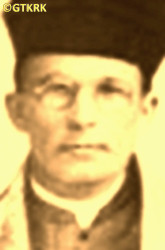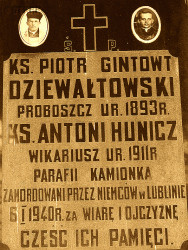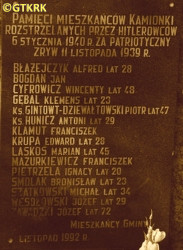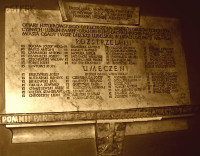Roman Catholic
St Sigismund parish
05-507 Słomczyn
85 Wiślana Str.
Konstancin deanery
Warsaw archdiocese, Poland
full list:
displayClick to display full list

searchClick to search full list by categories
wyświetlKliknij by wyświetlić pełną listę po polsku

szukajKliknij by przeszukać listę wg kategorii po polsku

Martyrology of the clergy — Poland
XX century (1914 – 1989)
personal data
surname
GINTOWT-DZIEWAŁTOWSKI
forename(s)
Peter (pl. Piotr)
function
diocesan priest
creed
Latin (Roman Catholic) Church RCmore on
en.wikipedia.org
[access: 2014.09.21]
diocese / province
Lublin diocesemore on
pl.wikipedia.org
[access: 2013.05.19]
Vilnius diocesemore on
en.wikipedia.org
[access: 2013.05.19]
date and place
of death
06.01.1940

Lublintoday: Lublin city pov., Lublin voiv., Poland
more on
en.wikipedia.org
[access: 2021.08.20]
details of death
After German and Russian invasion of Poland in 09.1939 and start of the World War II, after start of German occupation, arrested on by the Germans on 15.11.1939 — for allowing his parishioners to sing the hymn „God save Poland”, with words „Return o Lord our free Homeland”, on 11.11.1939, on the national day of Poland — together with his vicar, Fr Anthony Hunicz, and 13 inhabitants of Kamionka village.
All were brought to Lubartów where were held in an jail set up in contemporary Gymnasium No. 2 building.
Next all were transported to a prison in the Castle in Lublin, where they were joined in by Fr Vaclav Kosior, parish priest of Chełm parish.
On 15.12.1939 German Germ. Standgericht der Sicherheitspolizei (Eng. Security Police Summary Court) sentenced almost all to death, including Fr Peter Gintowt–Dziewałtowski and Fr Vaclav Justin Kosior.
On the morning of 06.01.1940 policemen of German police battalion from Kalinowszczyzna executed them all — plus a dozen or so other prisoners, altogether 26 Poles (according to other sources 50) — in Lemszczyzna district of Lublin.
cause of death
mass murder
perpetrators
Germans
sites and events
LemszczyznaClick to display the description, Lublin (Castle)Click to display the description, 11.1939 arrests (Lublin)Click to display the description, «Intelligenzaktion»Click to display the description, Ribbentrop‐MolotovClick to display the description, Pius XI's encyclicalsClick to display the description
date and place
of birth
29.06.1893

presbyter (holy orders)
ordination
06.01.1919

positions held
1935 – 1940
parish priest — Kamionkatoday: Kamionka gm., Lubartów pov., Lublin voiv., Poland
more on
en.wikipedia.org
[access: 2021.08.20] ⋄ Assumption of the Blessed Virgin Mary and St Peter and St Paul the Apostles RC parish ⋄ Lubartówtoday: Lubartów gm., Lubartów pov., Lublin voiv., Poland
more on
en.wikipedia.org
[access: 2021.08.20] RC deanery
1926 – 1935
parish priest — Konopnicatoday: Konopnica gm., Lublin pov., Lublin voiv., Poland
more on
en.wikipedia.org
[access: 2021.12.19] ⋄ Assumption of the Blessed Virgin Mary RC parish ⋄ Lublin suburbsdeanery name
today: Lublin voiv., Poland RC deanery
c. 1926
administrator — Konopnicatoday: Konopnica gm., Lublin pov., Lublin voiv., Poland
more on
en.wikipedia.org
[access: 2021.12.19] ⋄ Assumption of the Blessed Virgin Mary RC parish ⋄ Lublin suburbsdeanery name
today: Lublin voiv., Poland RC deanery
c. 1921 – c. 1925
vicar — Konopnicatoday: Konopnica gm., Lublin pov., Lublin voiv., Poland
more on
en.wikipedia.org
[access: 2021.12.19] ⋄ Assumption of the Blessed Virgin Mary RC parish ⋄ Lublin suburbsdeanery name
today: Lublin voiv., Poland RC deanery
1919 – c. 1920
student — Lublintoday: Lublin city pov., Lublin voiv., Poland
more on
en.wikipedia.org
[access: 2021.08.20] ⋄ Department of Canon Law and Moral Sciences, Catholic University of Lublin KUL [i.e. Catholic University of Lublin KUL (since 1928) / clandestine Catholic University of Lublin KUL (1939‐1944) / University of Lublin (1918‐1928)]
from 1914
student — Vilniustoday: Vilnius city dist., Vilnius Cou., Lithuania
more on
en.wikipedia.org
[access: 2022.01.06] ⋄ philosophy and theology, Theological Seminary
others related
in death
CIEŚLIKClick to display biography Stanislav, GORALClick to display biography Vladislav, HUNICZClick to display biography Anthony, KOSIORClick to display biography Vaclav Justin, LENARTClick to display biography John, MICHALEWSKIClick to display biography John Theophilus, MYSAKOWSKIClick to display biography Stanislav Francis, NIECHAJClick to display biography Michael, OCHALSKIClick to display biography Zdislav Anthony, POBOŻYClick to display biography Anthony, SUROWSKIClick to display biography Dominic, SZYSZKOClick to display biography Louis, WOJSAClick to display biography Stanislav Boleslav, ZAWISTOWSKIClick to display biography Anthony
sites and events
descriptions
Lemszczyzna: 06.01.1940 Germans, as part of „Sonderaktion Lublin” — extermination of the Polish intelligentsia in Lublin and vicinity — exterminated in a mass murder in clay pits near „Lemszczyzna” brick factory c. 50 Poles, including inhabitants of Kamionka arrested on 15.11.1939 for celebrating national day on 11.11.1939. Among the executed were at least 3 priests. (more on: pl.wikipedia.orgClick to attempt to display webpage
[access: 2013.06.23])
Lublin (Castle): During World War II, the Germ. Gefängnis der Sicherheitspolizei und des Sicherheitsdienst Lublin (Eng. Police and Security Service SD Prison), through which c. 40,000‐80,000 Poles passed during the German occupation, mostly members of Polish clandestine independence organizations (part of the Polish Clandestine State), before being sent by the Germans to concentration camps. The inmates were held in inhumane conditions, in overcrowded cells — up to 3,000 were held at one time in the prison designed for 700 people — where they were starved, harassed, and disease was rampant. During interrogations were tortured. Many were murdered — the prison housed the genocidal Germ. Sondergericht (Eng. special court), which issued serial death sentences after a trial lasting several minutes. C. 2,200 perished during the investigation or in the prison; 4,500 were murdered in secret executions in the vicinity of Lublin. When the Russians were fast approached Lublin in 08.1944, c. 1,500 prisoners were sent to the KL Lublin concentration camp, where were murdered, and on 22.07.1944, after a few hours prior to escape, c. 300 remaining were murdered in the prison itself. After the expulsion of the Germans in 1944, the prison was first run by Russians, then UB, the Polish branch of the Russian NKVD, and 32,000‐33,000 soldiers of the Home Army AK, part of the Polish Clandestine State, and the National Armed Forces NSZ, fighting against the Russian occupation, were detained there (in similar conditions to the Germans — in 04.1945 c. 8,000 people were held in the prison) and tortured. C. 515 were sentenced to death and 333 were murdered. The prison began to be liquidated in 02.1954. (more on: en.wikipedia.orgClick to attempt to display webpage
[access: 2015.09.30])
11.1939 arrests (Lublin): As part of «Intelligenzaktion» — extermination of Polish leading classes — that in Lublin took form of Sonderaktion Lublin (Eng. Action Special Lublin) on 11.1939 c. 2,000 intellectuals from Lublin were arrested by the Germans. On 11.11.1939 Germans entered Lublin Catholic University KUL and arrested 15 professors and lecturers of Lublin Theological Seminary. On 17.11.1939 Lublin ordinary, Bp Marian Fulman, his deputy Bp Vladislav Goral and 11 other clerics were arrested. Curial building got robbed. In 11.1939 Germans formally closed KUL off, as well as Lublin schools and theatres. Altogether c. 100 clerics from Lublin and vicinity were arrested. All were locked in Castle prison in Lublin. On 27.11.1939 13 priests were sentenced by German Sondergericht (Eng. special court) to death. Those sentences were commuted later to life imprisonment. Most of the priests were on 04.12.1939 transported to KL Sachsenhausen concentration camp and from there to KL Dachau concentration camp. Many were murdered. (more on: pl.wikipedia.orgClick to attempt to display webpage
[access: 2016.03.14])
«Intelligenzaktion»: German: «Intelligenzaktion» (English: „Intelligence Action”) — a German program of extermination of the Polish elite, mainly the intelligentsia and leadership layers, carried out from the beginning of the occupation in w 09.1939 to 04.1940, mainly in territories directly annexed to Germany, but also in the so‐called Germ. Generalgouvernement (Eng. General Governorate), where it was called «AB‐aktion». In the first phase, immediately after the beginning of the German occupation, during military operations carried out by the Germ. Wehrmacht (Eng. Armed Forces) and the genocidal units of the Germ. Einsatzgruppen (Eng. Operational Groups) of the Germ. Sicherheitspolizei (Eng. Security Police), i.e. SiPo, and Germ. Sicherheitsdienst des Reichsführers SS (Eng. Security Service of the Reichsführer SS), i.e. SD, organized by the Germ. Reichssicherheitshauptamt (Eng. Reich Main Security Office), i.e. RSHA, which followed the troops, carried out under the Germ. Unternehmen „Tannenberg” (Eng. Operation „Tannenberg”) — based on the so‐called Germ. Sonderfahndungsliste (Eng. Special Wanted Lists), i.e. proscription lists of Poles considered particularly dangerous to the Third Reich, prepared by the Zentralstelle II/P (Polen) unit of the German RSHA. Later, implemented by the German civilian occupation authorities and the genocidal unit of the Germ. Volksdeutscher Selbstschutz (Eng. Ethnic Germans Self‐Defense), whose members were Germ. Volksdeutsche (Eng. Ethnic Germans), i.e. representatives of the German minority in Poland. According to various sources, these lists, at the beginning of 09.1939, could have contained the details of 61,000—88,000 „dangerous” Poles — although these figures cannot be confirmed. In total, during this genocide, c. 50,000 teachers, Catholic priests, representatives of the landed gentry, freelancers, social and political activists, and retired military personnel were systematically and methodically murdered. Another 50,000 were sent to concentration camps, where only a negligible percentage survived. (more on: en.wikipedia.orgClick to attempt to display webpage
[access: 2014.10.04])
Ribbentrop‐Molotov: Genocidal Russian‐German alliance pact between Russian leader Joseph Stalin and German leader Adolf Hitler signed on 23.08.1939 in Moscow by respective foreign ministers, Mr. Vyacheslav Molotov for Russia and Joachim von Ribbentrop for Germany. The pact sanctioned and was the direct cause of joint Russian and German invasion of Poland and the outbreak of the World War II in 09.1939. In a political sense, the pact was an attempt to restore the status quo ante before 1914, with one exception, namely the „commercial” exchange of the so‐called „Kingdom of Poland”, which in 1914 was part of the Russian Empire, fore Eastern Galicia (today's western Ukraine), in 1914 belonging to the Austro‐Hungarian Empire. Galicia, including Lviv, was to be taken over by the Russians, the „Kingdom of Poland” — under the name of the General Governorate — Germany. The resultant „war was one of the greatest calamities and dramas of humanity in history, for two atheistic and anti‐Christian ideologies — national and international socialism — rejected God and His fifth Decalogue commandment: Thou shall not kill!” (Abp Stanislav Gądecki, 01.09.2019). The decisions taken — backed up by the betrayal of the formal allies of Poland, France and Germany, which on 12.09.1939, at a joint conference in Abbeville, decided not to provide aid to attacked Poland and not to take military action against Germany (a clear breach of treaty obligations with Poland) — were on 28.09.1939 slightly altered and made more precise when a treaty on „German‐Russian boundaries and friendship” was agreed by the same murderous signatories. One of its findings was establishment of spheres of influence in Central and Eastern Europe and in consequence IV partition of Poland. In one of its secret annexes agreed, that: „the Signatories will not tolerate on its respective territories any Polish propaganda that affects the territory of the other Side. On their respective territories they will suppress all such propaganda and inform each other of the measures taken to accomplish it”. The agreements resulted in a series of meeting between two genocidal organization representing both sides — German Gestapo and Russian NKVD when coordination of efforts to exterminate Polish intelligentsia and Polish leading classes (in Germany called «Intelligenzaktion», in Russia took the form of Katyń massacres) where discussed. Resulted in deaths of hundreds of thousands of Polish intelligentsia, including thousands of priests presented here, and tens of millions of ordinary people,. The results of this Russian‐German pact lasted till 1989 and are still in evidence even today. (more on: en.wikipedia.orgClick to attempt to display webpage
[access: 2015.09.30])
Pius XI's encyclicals: Facing the creation of two totalitarian systems in Europe, which seemed to compete with each other, though there were more similarities than contradictions between them, Pope Pius XI issued in 03.1937 (within 5 days) two encyclicals. In the „Mit brennender Sorge” (Eng. „With Burning Concern”) published on 14.03.1938, condemned the national socialism prevailing in Germany. The Pope wrote: „Whoever, following the old Germanic‐pre‐Christian beliefs, puts various impersonal fate in the place of a personal God, denies the wisdom of God and Providence […], whoever exalts earthly values: race or nation, or state, or state system, representatives of state power or other fundamental values of human society, […] and makes them the highest standard of all values, including religious ones, and idolizes them, this one […] is far from true faith in God and from a worldview corresponding to such faith”. On 19.03.1937, published „Divini Redemptoris” (Eng. „Divine Redeemer”), in which criticized Russian communism, dialectical materialism and the class struggle theory. The Pope wrote: „Communism deprives man of freedom, and therefore the spiritual basis of all life norms. It deprives the human person of all his dignity and any moral support with which he could resist the onslaught of blind passions […] This is the new gospel that Bolshevik and godless communism preaches as a message of salvation and redemption of humanity”… Pius XI demanded that the established human law be subjected to the natural law of God , recommended the implementation of the ideal of a Christian state and society, and called on Catholics to resist. Two years later, National Socialist Germany and Communist Russia came together and started World War II. (more on: www.vatican.vaClick to attempt to display webpage
[access: 2023.05.28], www.vatican.vaClick to attempt to display webpage
[access: 2023.05.28])
sources
personal:
ltg.plClick to attempt to display webpage
[access: 2013.12.04], www.turystyka.lgdlubartow.org.plClick to attempt to display webpage
[access: 2013.12.04]
original images:
kamionka.parafia.info.plClick to attempt to display webpage
[access: 2014.08.14], kamionka.parafia.info.plClick to attempt to display webpage
[access: 2014.08.14], www.polskaniezwykla.plClick to attempt to display webpage
[access: 2019.10.13], www.miejscapamiecinarodowej.plClick to attempt to display webpage
[access: 2014.05.09]
LETTER to CUSTODIAN/ADMINISTRATOR
If you have an Email client on your communicator/computer — such as Mozilla Thunderbird, Windows Mail or Microsoft Outlook, described at WikipediaPatrz:
en.wikipedia.org, among others — try the link below, please:
LETTER to CUSTODIAN/ADMINISTRATORClick and try to call your own Email client
If however you do not run such a client or the above link is not active please send an email to the Custodian/Administrator using your account — in your customary email/correspondence engine — at the following address:

giving the following as the subject:
MARTYROLOGY: GINTOWT-DZIEWAŁTOWSKI Peter
To return to the biography press below:
 Click to return to biography
Click to return to biography











